Why does Base, the most profitable L2, earn $180,000 a day?
Written by Zack Pokorny
Compiled by: Luffy, Foresight News
Base, created by cryptocurrency exchange Coinbase, is the most income-generating platform in the Ethereum Layer2 (L2) network, often earning more daily than all other top rollup projects combined. Over the past 180 days, Base's average daily gains have reached $185,291, far surpassing the second-ranked Arbitrum's $55,025.
Obviously, Base has become a consistently high-income platform, but what is the driving force behind its economic activity? What advantages does Base have that other leading L2s do not have, and can create such high value?
This report will explore Base's fee structure and highlight the activities driving its revenue growth. We found that Base's ordering mechanism and decentralized exchange (DEX) activity were key drivers.
Base's transaction ordering mechanism
The order of transactions on Base is determined by two variables:
-
transaction submission time (delay);
-
The fee paid by the sender relative to the transaction complexity (financial incentive).
This mechanism is similar to how logistics companies like UPS operate: packages are sent in the order in which they are delivered, while allowing senders to opt for "expedited" delivery for an additional fee for faster delivery. The priority fee mechanism forms a dynamic auction market that aligns with Ethereum's EIP-1559 fee model, balancing delivery time with financial incentives.
Specifically, transactions on Base include a "base fee" (lowercase "b", not to be confused with the chain's name) and a priority fee: all users pay a base fee when sending transactions, while the priority fee is optional and is only used to speed up transaction execution.
But how does the sequencer decide which "expedited" transaction to prioritize? It doesn't directly consider the total cost, but rather the price per unit of gas (compute resources required), which is the cost performance of the resources required for the transaction and the yield it generates.
Let's use the example of a logistics company: Suppose a delivery truck has limited space (similar to a block's gas cap), and the driver (sequencer) wants to maximize tipping revenue in the limited space. There are two packages at this point:
-
A large package with $50 for base shipping but only $10 for priority tipping takes up half a truck of space;
-
A small package with a base shipping fee of only $20 and a priority tip of the same $10 takes up very little space.
Although the total cost of a large package is $30 more than a small package, drivers will still prioritize loading small packages because it is more cost-effective in terms of space occupied.
Base's sequencer follows the same logic, prioritizing transactions with the highest priority fees per unit of gas, ensuring that the "most expensive" block of computational resources is also the most profitable block. Therefore, when two users submit transactions simultaneously, regardless of transaction complexity or total fees, users who pay higher priority fees per unit of gas are more likely to have their transactions prioritized for inclusion in the block.
The following diagram illustrates this process:
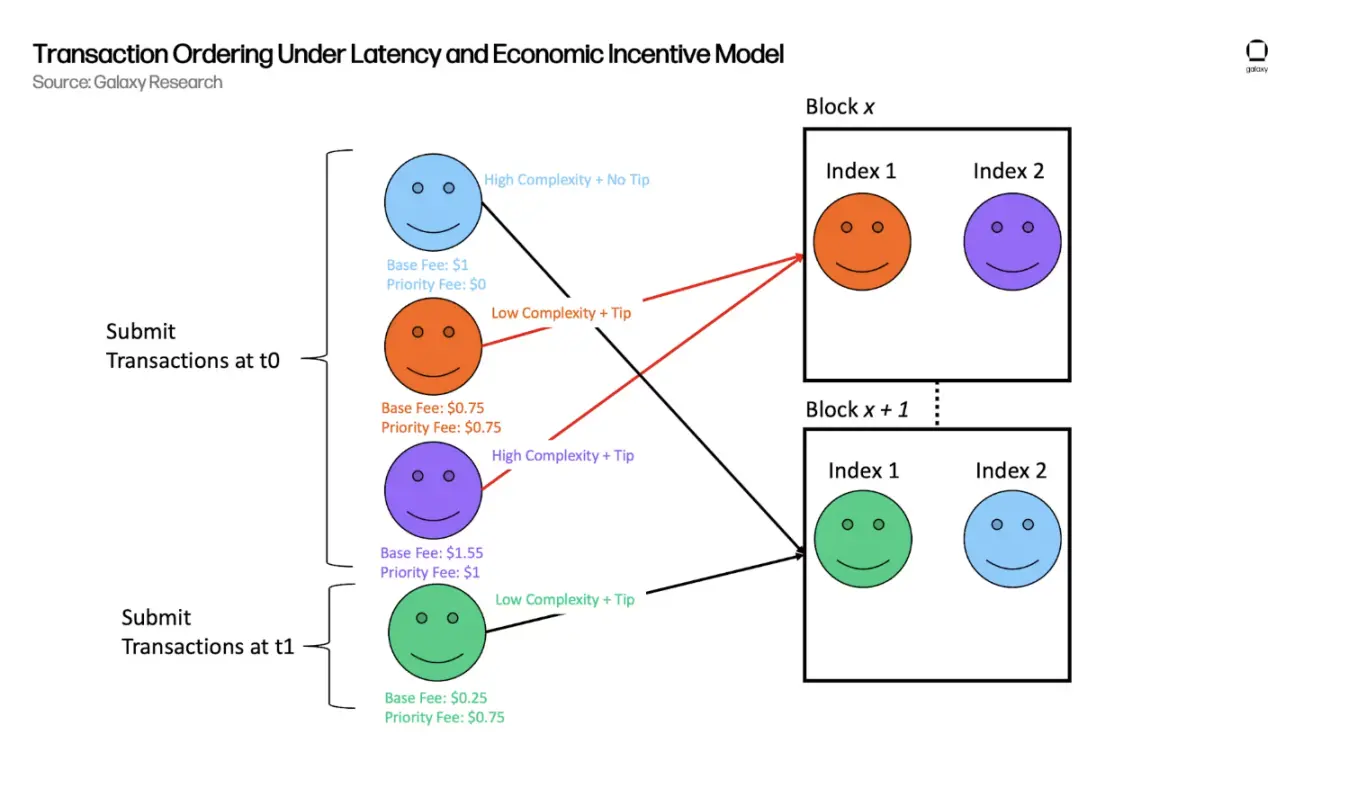
Why is this important? How is Base different from competing chains?
Base's EIP-1559-style fee model creates a continuous open market auction environment for block space, where users can bid directly for block space based on the urgency and profitability of the transaction. Therefore, while there is still a delayed competition factor, the economics allow sequencers' revenue to grow directly with block space demand and the profitability of on-chain transactions.
This is in stark contrast to Arbitrum's primary sorting mechanism. Arbitrum operates on a strict "first-come, first-served" (FCFS) model, where users primarily compete for latency rather than economic costs. In this model, the main competition is not who can pay more because the fee per gas is the same for all users and no priority fees are used, but who can get transactions to the sequencer the fastest. This has led to a "latency race," where professional participants ensure their transactions are prioritized by investing in low-latency infrastructure. In this environment, Arbitrum's fees only grow with the scale of demand and do not effectively reflect the profitability or urgency of a single transaction.
In April 2025, Arbitrum launched the Timeboost feature, which aims to create a more flexible FCFS system, enabling sequencers to earn similar priority fee benefits. In fact, Timeboost adds a "fast lane" for transaction execution to Arbitrum, which users can use for a limited time through bidding. Users entering the fast lane get near-instant execution, while other users are still processed in FCFS order, adding only 200 milliseconds of latency to compensate for the priority of the fast lane. Although Timeboost introduces some form of priority bidding, its mechanism is more predictive than reactive compared to Base's priority fee model. Bidders must forecast the potential total revenue for a period of time in the future and base their bids on an estimated bid. This means that Arbitrum receives a fixed fee from the winning bidder, regardless of the actual earnings during that time period. This active fixed-rate model is less effective at capturing the value of burst, high-yield transactions than reactive systems where users bid individually on each transaction.
How much revenue does Base generate?
Over the past 180 days, Base's average daily gain has stood at $185,291. In comparison, Arbitrum has an average daily gain of $55,025, and the other 14 Ethereum L2 networks have combined daily gains of $46,742.
Year-to-date, Base has earned $33.4 million, Arbitrum has $9.9 million, and 14 other L2 networks have $8.4 million.
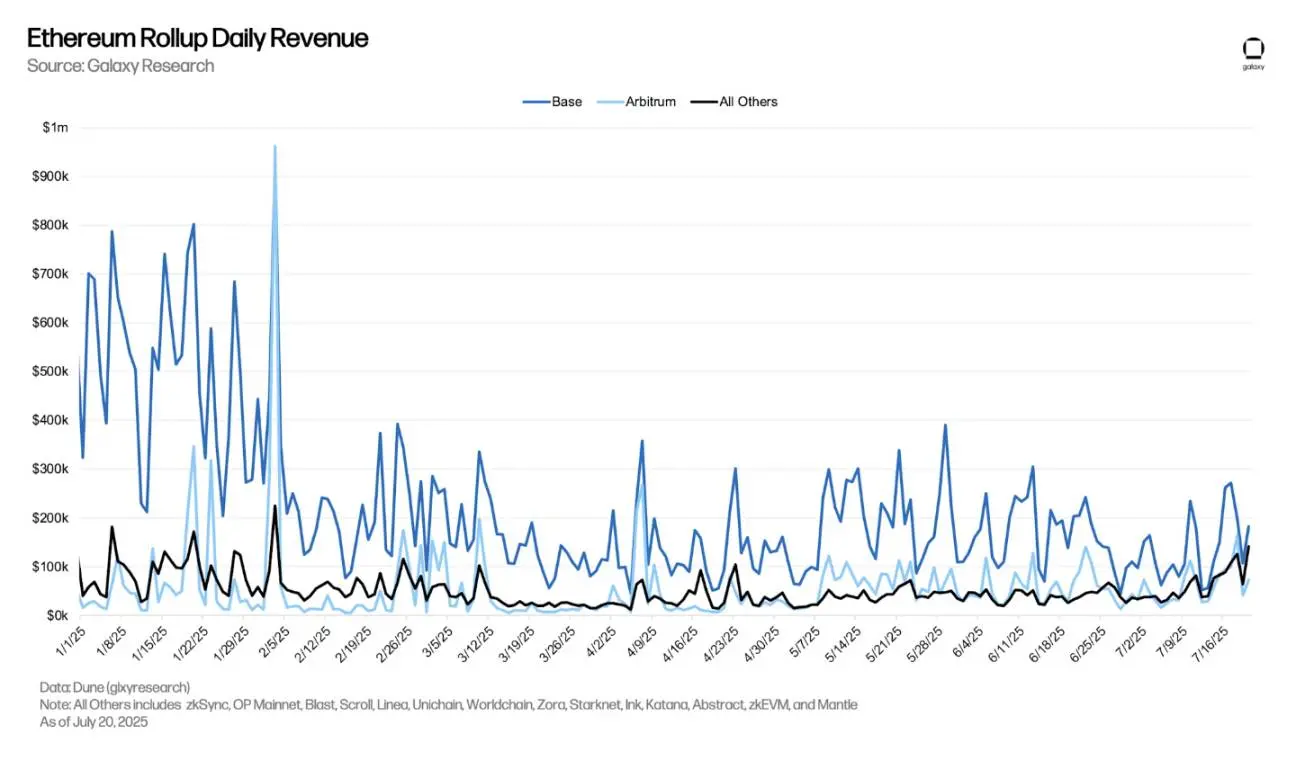
Comparatively, in the last 180 days, Base has accounted for 64% of the total yield of the 15 top Ethereum L2 networks ranked by total collateral value. Its share has grown significantly over the past year, rising by 48 percentage points from its daily average of 37% in July 2024, based on the 7-day moving average of daily earnings share. As of July 20, Base's share of Ethereum rollup revenue has dropped to 49.7% due to increased activity on other chains.
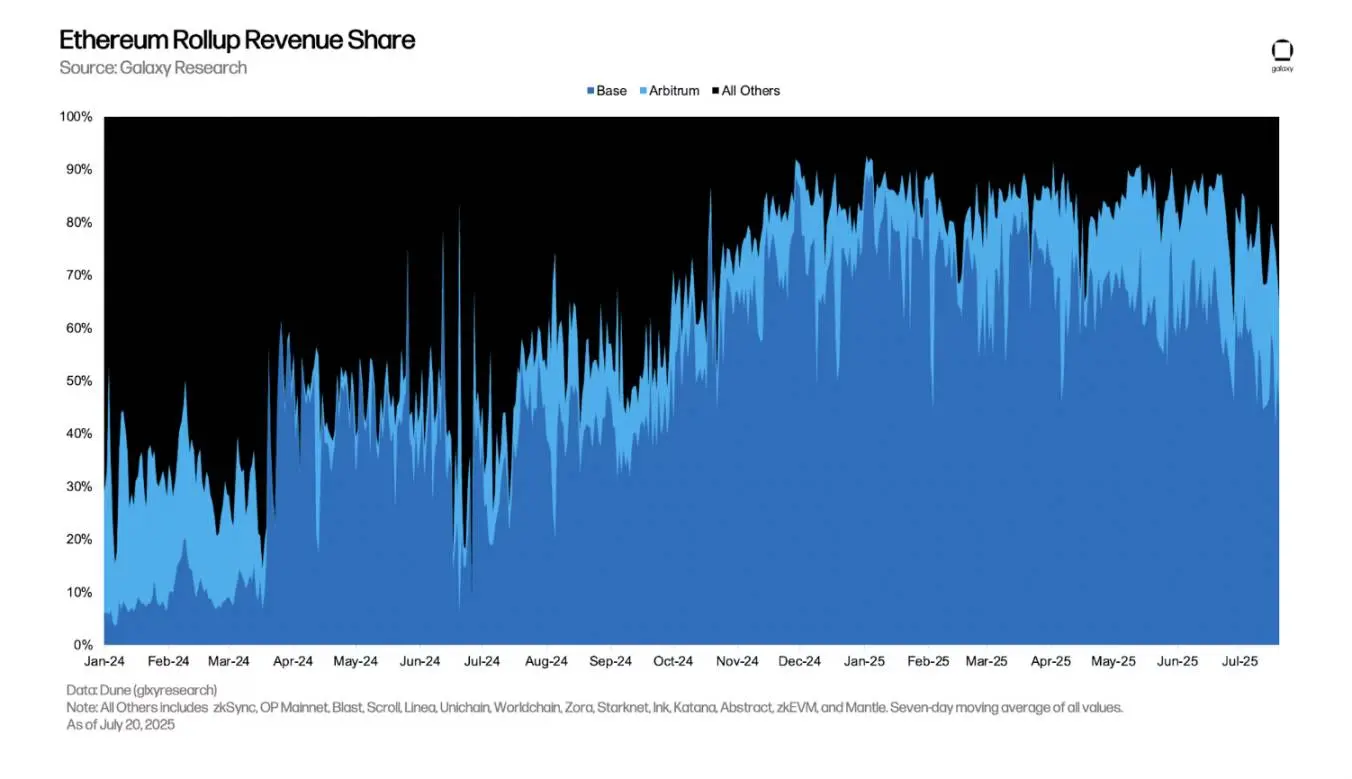
The important role of priority fees
Trading fees on Base consist of two main components and an optional priority fee:
-
Layer1 (L1) Fees: Used to cover the cost of submitting a batch of L2 transactions to the Ethereum mainnet. After the Ethereum Pectra upgrade introduced "blobs" through EIP-4844 in March 2024, the L1 fees for Base (and general L2 transactions) dropped significantly. This is because committing bulk data through blobs is more economically efficient than committing in the form of call data in L1 transactions.
-
Base Fee: A mandatory fee for executing trades on Base. Determined by the protocol, it fluctuates based on the usage of the previous block space - the busier the network, the higher the base fee; The opposite is the lower it is.
-
Priority Fees: Optional fees, also known as "tips," are used to prioritize the execution of trades. Priority fees help transactions get a higher position in the block or ensure that transactions are included in the current block rather than delayed to the next block. A block can contain thousands of transactions that are executed according to the order of their slots. Typically, the first slot of a block has the highest value because the transaction at that location is executed first and is not interfered with by subsequent transactions.
Priority fees are the primary source of Base earnings, and users receive accelerated execution through bidding. Over the past 180 days, Base's average daily priority fee earnings have reached $156,138, representing 86.1% of its average daily earnings.
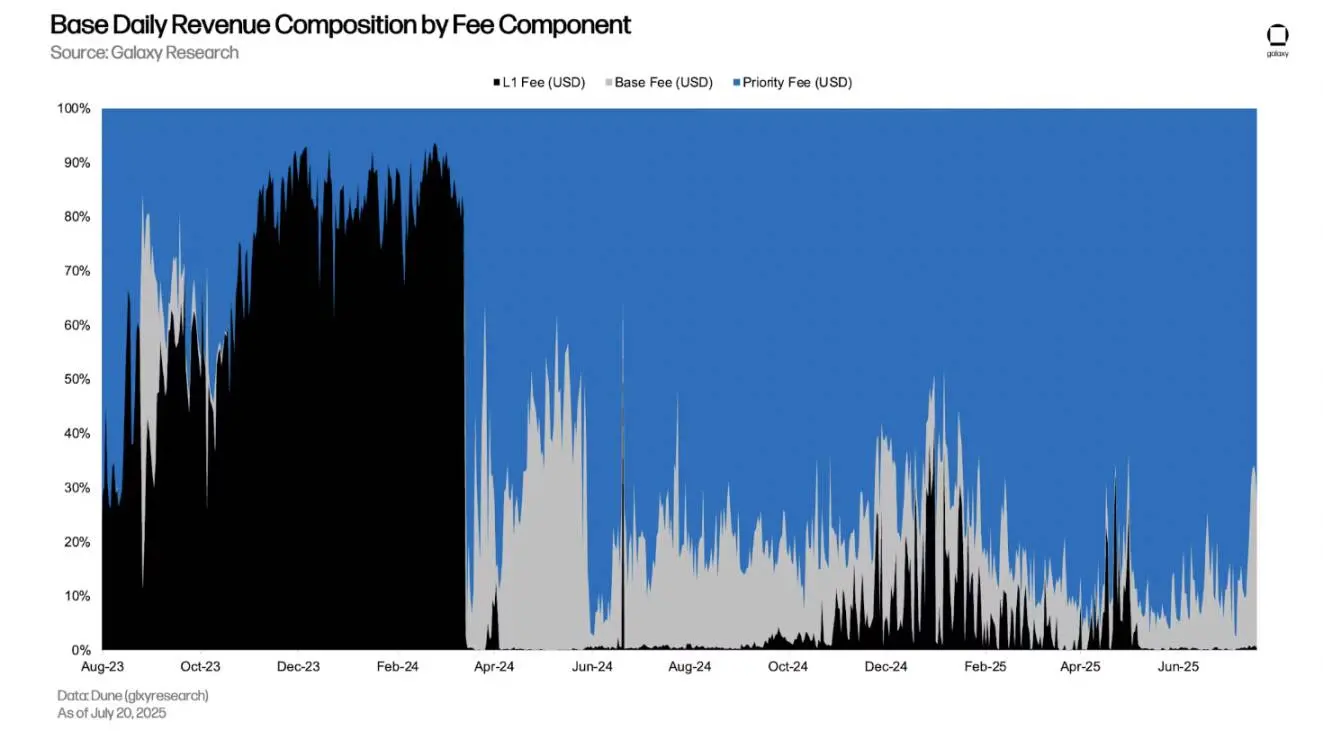
Specifically, the priority fee for the Base block top slot is a significant contributor to sequencer yield, with users vying for a spot near the top of the block. Since 2025, priority fees paid for transactions on the block's first slot alone have contributed 30% to 45% of daily gains. Additionally, priority fees paid by transactions for the top 10 slots per block during the same period contributed 50% to 80% of the daily gains. However, in the weeks following July 5, the share of top slot priority fees as a percentage of total daily earnings dropped significantly. This is due to two factors: 1) increased traffic pushes up base fees, which in turn dilutes the proportion of revenue from priority fees; 2) The implementation of "Flashblocks" on July 16 (more on this below) caused high-priority transactions to fall into the lower slots in the block (but as we will see, this is not a bad thing).
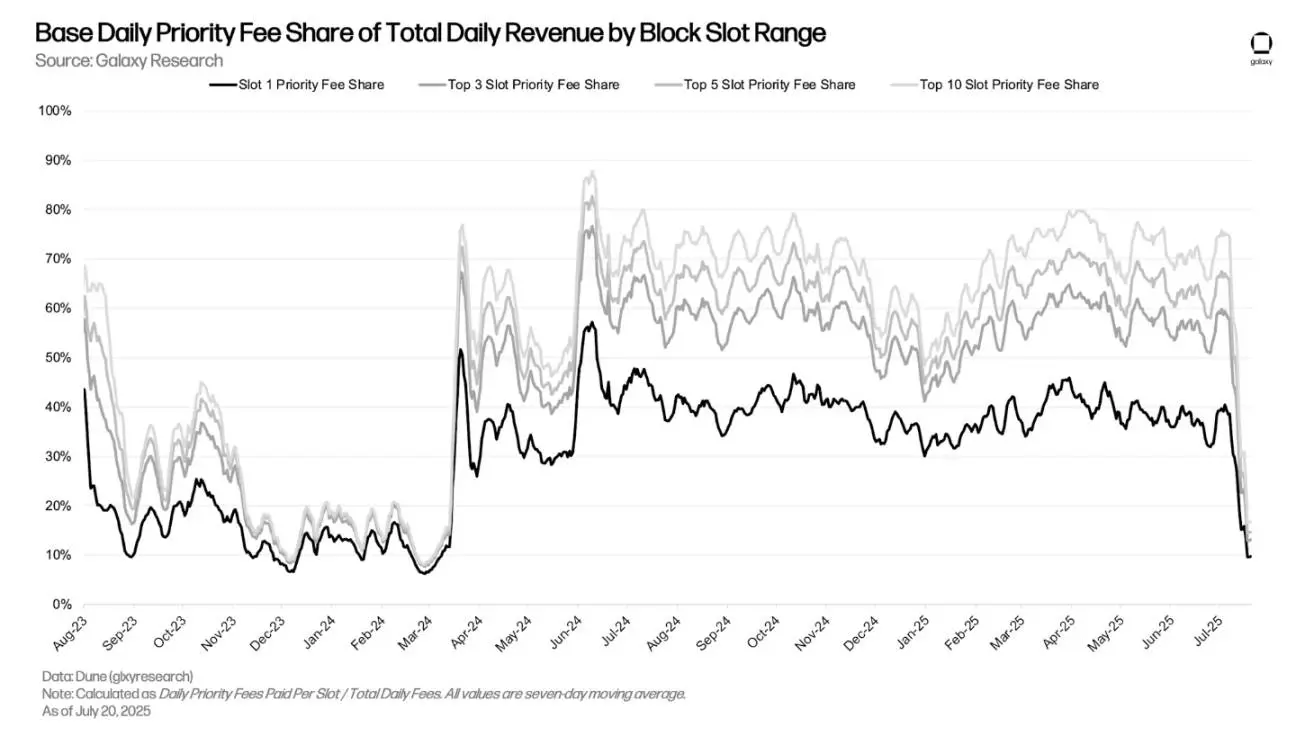
Priority fees are primarily from a small group of addresses, with 64.9% of priority fees coming from just 250 addresses in the past year. The number one address among them paid 3.6% of all priority fees during the same period, equivalent to $1.99 million in ETH prices at the time of fee payment.
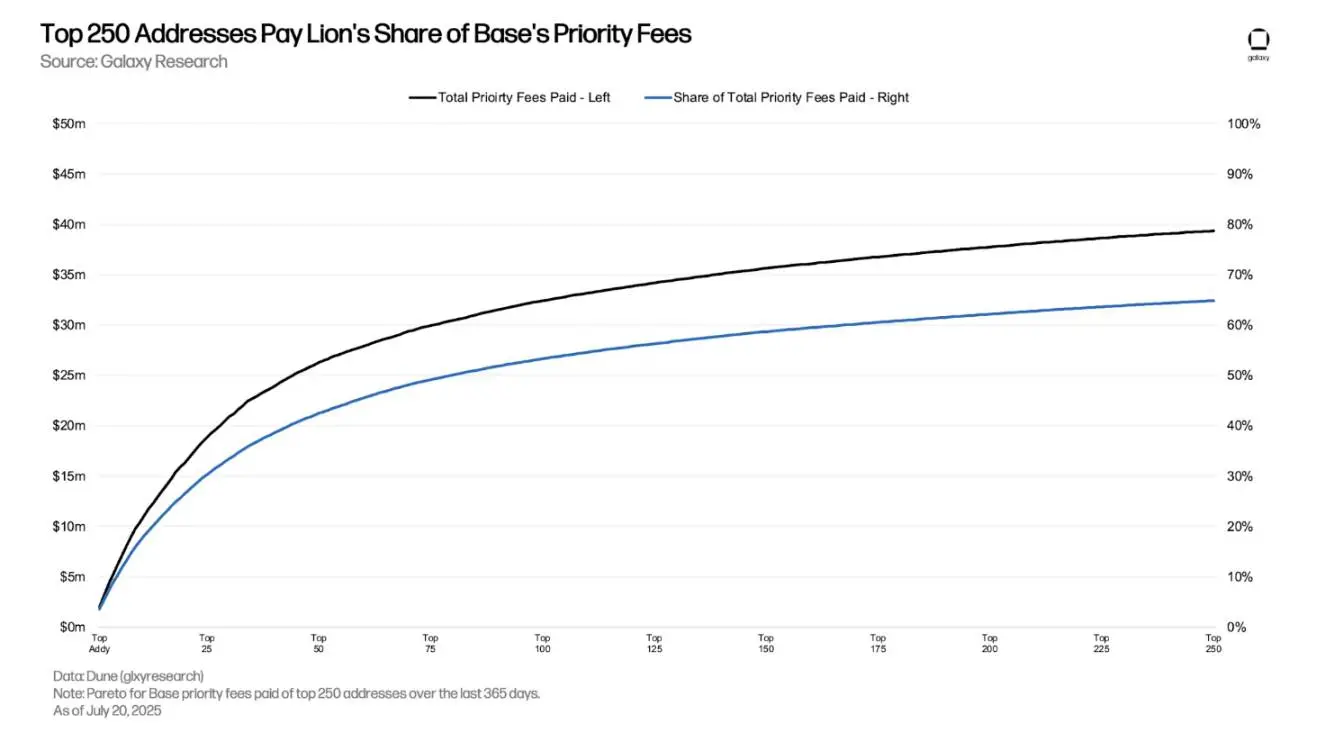
What is Flashblocks?
Flashblocks, developed by Flashbots, aims to improve transaction processing speed on Base. To achieve this, it introduces "sub-blocks," which are high-confidence preconfirmations of subsections of a block created at intervals of about 200 milliseconds. For example, a block can contain three different sub-sections, and users can get transaction pre-confirmations of these sub-parts before the block is confirmed on-chain at a set 2-second interval. This allows end-users to feel that transactions are completed almost instantly, even if Base's block interval remains the same, resulting in a smoother and more responsive experience.
Why is this essential for Base network fee analysis by slot? Because from a transaction ordering perspective, each "sub-block" is actually treated as a new block. As a result, high-priority fee transactions may fall into the lower slot of the overall "confirmed block" but at the top of the "preconfirmed subblock".
The chart below shows the difference in priority fee distribution among the top 200 block slots before and after the implementation of Flashblocks. The black bar chart represents the percentage of priority fees for each slot; The blue line represents the cumulative percentage of all slots up to that slot (Pareto distribution).

In the week leading up to Flashblocks' implementation, the Pareto curve rose sharply in the first 10 slots, followed by a linear increase towards the 200th slot. In contrast, within a week of Flashblocks' implementation, the Pareto curve was gentler at the lowest slot, only starting to rise steeply around the 50th slot of each block - indicating that high-priority fee transactions are falling into the later slots in the confirmed blocks.
The impact of DEX trading
DEX activity on Base is very active. Among all Ethereum L2 networks, Base has the largest daily DEX trading volume, accounting for 50% to 65% of the L2 network's DEX trading volume, and its total DEX locked value (TVL) is the highest among all L2 networks (excluding perpetual futures DEXs).
The active DEX activity is a significant reason for the high Base priority fees. 50% to 70% of the total fees that Base sequencers receive daily come from priority fees for DEX transactions. However, since July 7, DEX trading fees have dropped from 67% to just 34% of total daily fees. This is due to two aspects: 1) the increase in base costs dilutes the proportion of priority costs; 2) Increased competition for on-chain block space, forcing users to pay priority fees for non-DEX transactions.
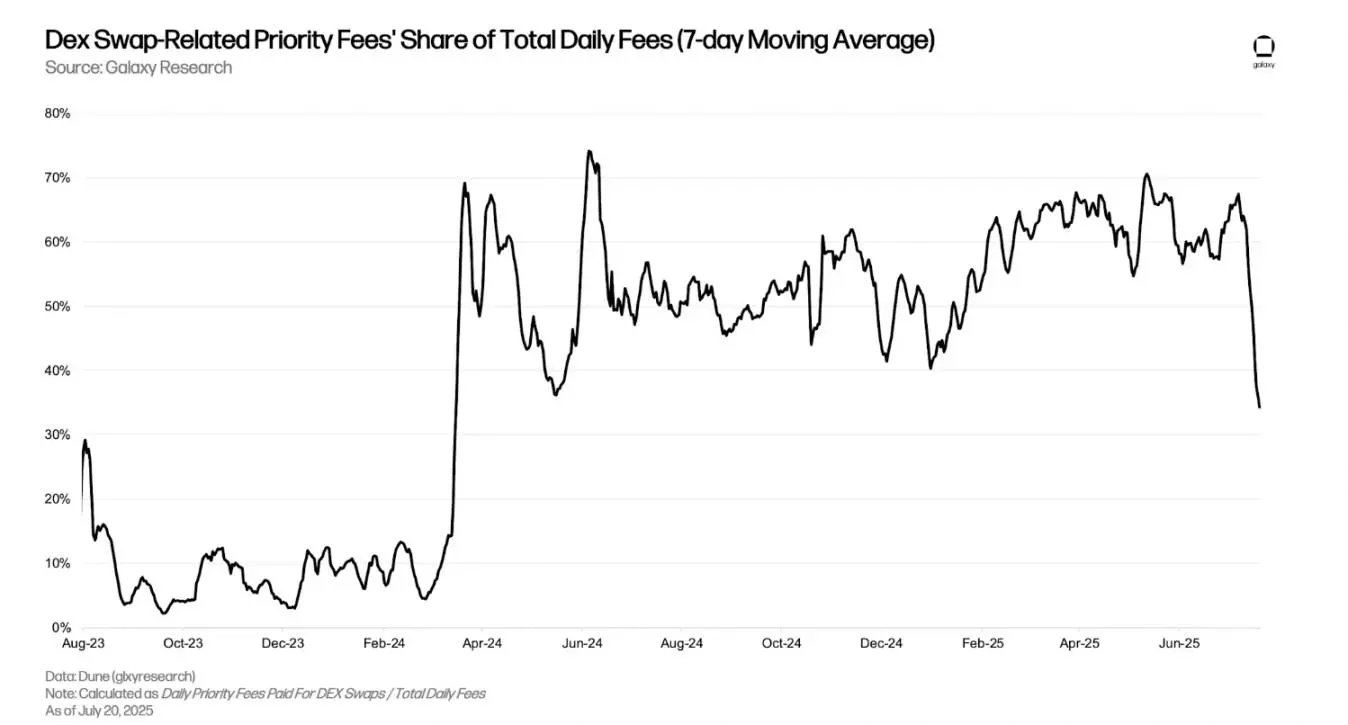
Since 2025, priority fees paid by DEX transactions on the first slot alone have contributed 30% to 35% of the total daily priority fees, while DEX transaction priority fees for the top three slots have contributed 50% to 62% of the total daily priority fees. The recent decline in the proportion of DEX priority fees in top slots is due to increased non-DEX transaction priority fees due to increased overall competition on the chain, and the implementation of Flashblocks that has caused high-priority DEX transactions to fall into lower slots in blocks.
conclusion
Through our analysis of Base's DeFi and yield structure, we find:
-
Priority fees make up the vast majority of income;
-
Over 60% of priority fees in the past year came from just 250 addresses;
-
High DEX trading volume and TVL;
-
Priority fees from DEX transactions contribute nearly three-quarters of the total priority fees.
These points suggest that Maximum Extractable Value (MEV) transactions, especially competitive activities like DEX arbitrage, are a significant source of Base sequencer yield. The EIP-1559-style fee model employed by the sequencer is a direct mechanism for achieving this: it transforms block space competition from inefficient latency-based competition to efficient economic auctions.
By charging priority fees to users willing to pay for emergency inclusion, this model enables sequencers to capture and commercialize the competitive value of block space more effectively than traditional "first-come, first-served" or latency-driven systems.
Recommended reading:
"Stop loss" turn? Joe McCann liquidated his old fund and moved to the new battlefield of Sol Treasury Company
Crypto Beast trading $ALT plummeted, adding another layer to the history of KOL collapse
